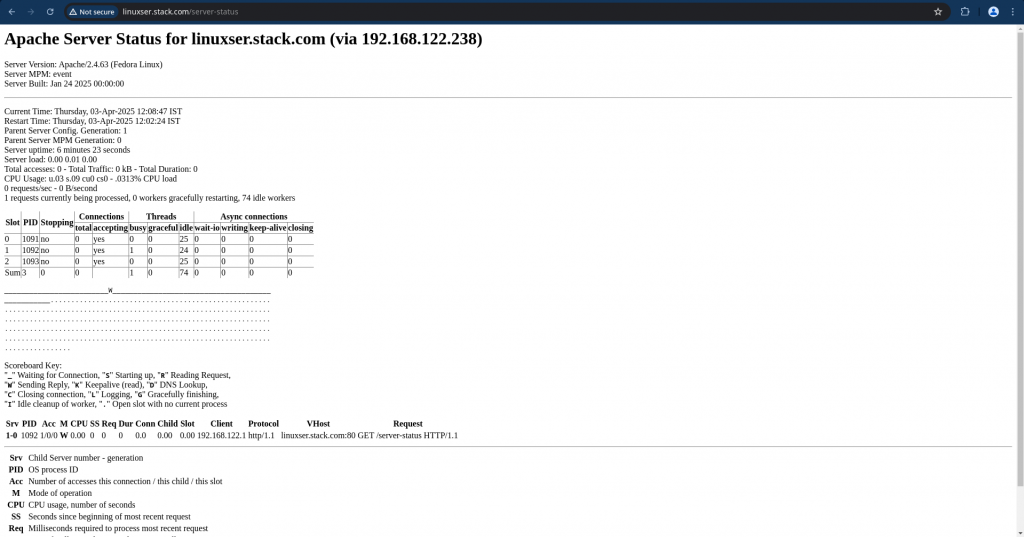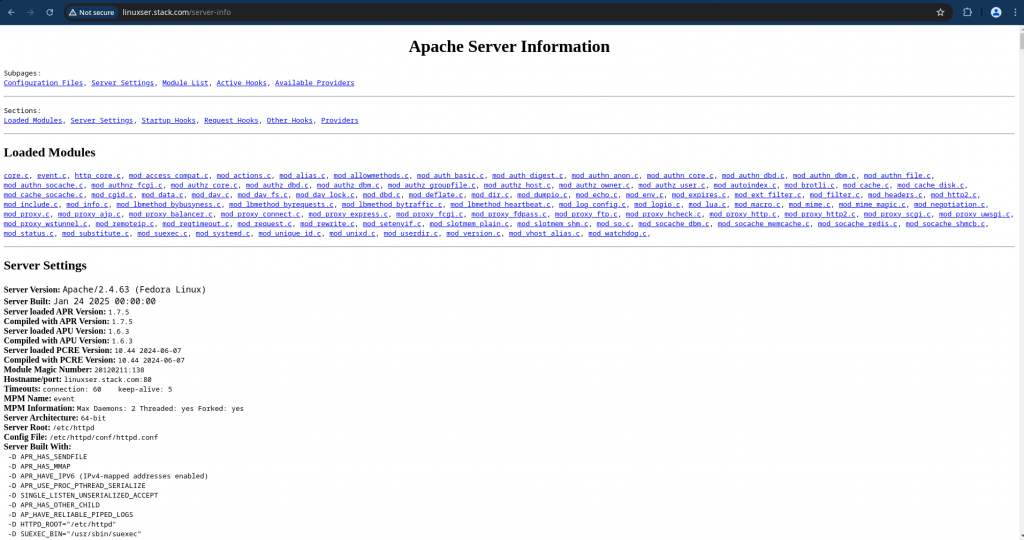How to Activate and Configure Apache HTTP Server Modules for Status and Configuration

Here in this article we will try to enable Apache HTTP server modules which provides comprehensive server configuration and status information.
Test Environment
- Fedora Server 41
Apache mod_status module
The mod_status module provides with current server statistics in an easily readable HTML formatted page. This information will help System Administrators in determining the performance of there httpd server and in troubleshooting any issues. It contains useful infomration such as httpd service uptime, avg request/second, avg bytes transferred per request and which worker process served a particular request and other information. For more details, please check the mod_status documentation.
Apache mod_info module
The mod_info module provides with the server configuration. The server information includes a list of all enabled modules, and for each module, a description of the directives understood by that module, the hooks implemented by that module, and the relevant directives from the current configuration. This module can leak sensitive information from the configuration directives of other Apache modules such as system paths, usernames/passwords, database names, etc. Therefore, this module should only be used in a controlled environment and always with caution. For more details, please check the mod_info documentation.
If you are interested in watching the video. Here is the YouTube video on the same step by step procedure outlined below.
Procedure
Step1: Ensure Apache HTTP server installed
As a first step you need to ensure that you have Apache HTTP server installed and running with the default configuration. Follow How to setup Apache HTTP Server using Ansible for the same.
Step2: Enable Apache Status and Configuration modules
By default the “mod_info” and “mod_status” modules are dynamically loaded. We can manually check if they are loaded or not by following command on the server where httpd service is installed.
admin@linuxser:~$ httpd -M | grep -E "info|status"
info_module (shared)
status_module (shared)
Once the modules are validated we can update httpd.conf by appending the below configuration at the EOF to enable server status and configuration. With the following configuration these information are available at “/server-status” and “/server-info” contexts.
Also as these modules provide sensitive information about our server configuration and status it is important to protect this resource. For this we will ensure that the following information is only accessible from Apache HTTP server host (ie. linuxser.stack.com) and one of the remote workstation (ie. 192.168.122.1 is gateway ip through which workstation network traffic routes externally) from where you want to manage the server remotely.
...
# Enable Server configuration
<Location "/server-info">
SetHandler server-info
Require host linuxser.stack.com
Require ip 192.168.122.1
</Location>
# Enable Server Status
<Location "/server-status">
SetHandler server-status
Require host linuxser.stack.com
Require ip 192.168.122.1
</Location>
Step3; Update Configuration
Now let us execute the role “linux_configure_httpd” using playbook “linux_setup_httpd.yml” to udpate the httpd service configuration.
admin@fedser:ahs$ ansible-playbook linux_setup_httpd.yml -i inventory/hosts --tags "linux_configure_httpd" -v
Step4: Restart Apache HTTP server
Once the httpd service configuration is updated we can restart the httpd service by stopping and starting the service using the below roles.
admin@fedser:ahs$ ansible-playbook linux_setup_httpd.yml -i inventory/hosts --tags "linux_stop_httpd" -v
admin@fedser:ahs$ ansible-playbook linux_setup_httpd.yml -i inventory/hosts --tags "linux_start_httpd" -v
Step5: Validate Server Status and Configuration information
Let us first check the “server-status” page which will provide a refreshed information every 5 seconds if the browser supports the refresh feature. Here is the below url for checking the same.
URL: http://linuxser.stack.com/server-status?refresh=5

Now, let us check the “server-info” page with the below url.
URL: http://linuxser.stack.com/server-info

We can also get the machine readable version of status file by accessing the below url.
URL: http://linuxser.stack.com/server-status?auto
WARNING: If mod_status and mod_info is loaded into the server, its handler capability is available in all configuration files, including per-directory files (e.g., .htaccess). This may have security-related ramifications for your site.
Hope you enjoyed reading this article. Thank you..
Leave a Reply
You must be logged in to post a comment.